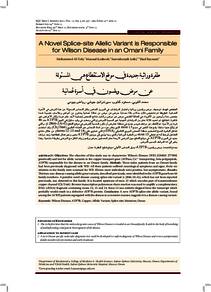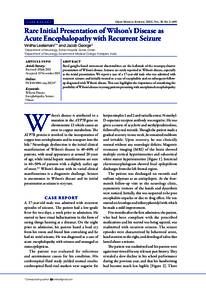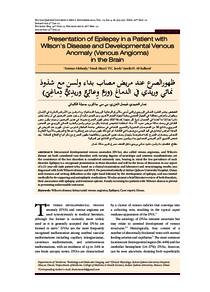وثيقة
A Novel splice-site allelic variant is responsible for Wilson disease in an Omani family.
المساهمون
عناوين أخرى
طفرة وراثية جديدة في موقع الاستقطاع هي المسؤلة عن مرض ويلسون في أسرة عمانية.
الناشر
College of Medicine, Sultan Qaboos University.
ميلادي
2011-08
اللغة
الأنجليزية
الموضوع
الملخص الإنجليزي
The objective of this study was to characterise Wilson's Disease (WD) [OMIM 277900] genetically and test for allelic variants in the copper transport gene (ATPase, Cu++ transporting, beta polypeptide, ATP7B) responsible for the disease in an Omani family. Methods: Three index patients from an Omani family had been previously diagnosed with WD. All three patients suffered neurological symptoms and signs. Forty-six relatives in the family were screened for WD. Eleven more individuals were positive, but asymptomatic. Results: Thirteen non-disease-causing allelic gene variants, described previously, were identified in the ATP7B gene from 46 family members. A putative novel disease-causing splice-site variant (c.2866-2A>G), which has not been reported previously, was detected in this family. It is located upstream of exon 13 which encodes part of transmembrane copper channel (Ch/Tm6). Reverse transcription polymerase chain reaction was used to amplify a complementary DNA (cDNA) fragment containing exons 12, 13 and 14. Exon 13 was entirely skipped from the transcript which probably would result in a defective ATP7B protein. Conclusion: A new ATP7B splice-site allelic variant, found among the 14 WD patients segregated with the disease in a recessive manner, suggests it is a disease-causing variant.
المجموعة
URL المصدر
zcustom_txt_2
Al-Tobi, Mohammed, Kashoob, Masoud, Joshi, Surendranath, & Bayoumi, Riad (2011). A Novel Splice-site Allelic Variant is Responsible for Wilson Disease in an Omani Family. Sultan Qaboos University Medical Journal,11( 3) 362-357.
الملخص العربي
كان الهدف من هذه الدراسة هو توصيف مرض ويلسون (WD) [OMIM 277900] وراثيًا واختبار المتغيرات الأليلية في جين نقل النحاس (ATPase ، نقل Cu ++ ، بيتا بولي ببتيد ، ATP7B) المسؤول عن المرض في عائلة عمانية. الطريقة: تم تشخيص ثلاثة مرضى من عائلة عمانية سابقًا بالإصابة بداء السكري. عانى المرضى الثلاثة من أعراض وعلامات عصبية. تم فحص 46 من أقارب الأسرة بحثًا عن WD. كان 11 شخصًا أكثر إيجابية ، لكن بدون أعراض. النتائج: تم تحديد ثلاثة عشر نوعًا من أنواع الجينات الأليلية غير المسببة للأمراض ، الموصوفة سابقًا ، في جين ATP7B من 46 فردًا من العائلة. تم اكتشاف متغير موقع لصق جديد مفترض يسبب المرض (c.2866-2A> G) ، والذي لم يتم الإبلاغ عنه مسبقًا ، في هذه العائلة. يقع في الجزء العلوي من exon 13 الذي يشفر جزءًا من قناة النحاس عبر الغشاء (Ch / Tm6). تم استخدام تفاعل البوليميراز المتسلسل للنسخ العكسي لتضخيم جزء DNA التكميلي (cDNA) الذي يحتوي على exons 12 و 13 و 14. تم تخطي Exon 13 بالكامل من النسخة التي من المحتمل أن تؤدي إلى بروتين ATP7B معيب. الخلاصة: هناك نوع جديد من الأليلات في موقع لصق ATP7B ، تم العثور عليه بين 14 مريضًا من مرضى WD مفصولين عن المرض بطريقة متنحية ، يشير إلى أنه متغير يسبب المرض.
قالب العنصر
مقالات الدوريات



